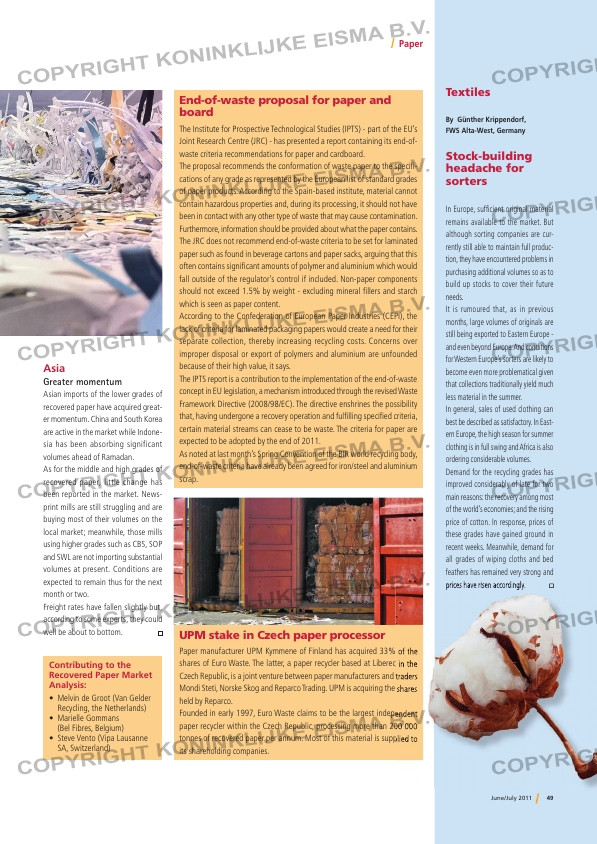Page 49 from: June / July 2011

Paper
Contributing to the
Recovered Paper Market
Analysis:
• Melvin de Groot (Van Gelder
Recycling, the Netherlands)
• Marielle Gommans
(Bel Fibres, Belgium)
• Steve Vento (Vipa Lausanne
SA, Switzerland)
Asia
Greater momentum
Asian imports of the lower grades of
recovered paper have acquired great-
er momentum. China and South Korea
are active in the market while Indone-
sia has been absorbing significant
volumes ahead of Ramadan.
As for the middle and high grades of
recovered paper, little change has
been reported in the market. News-
print mills are still struggling and are
buying most of their volumes on the
local market; meanwhile, those mills
using higher grades such as CBS, SOP
and SWL are not importing substantial
volumes at present. Conditions are
expected to remain thus for the next
month or two.
Freight rates have fallen slightly but,
according to some experts, they could
well be about to bottom.
End-of-waste proposal for paper and
board
The Institute for Prospective Technological Studies (IPTS) – part of the EU’s
Joint Research Centre (JRC) – has presented a report containing its end-of-
waste criteria recommendations for paper and cardboard.
The proposal recommends the conformation of waste paper to the specifi –
cations of any grade as represented by the European list of standard grades
of paper products. According to the Spain-based institute, material cannot
contain hazardous properties and, during its processing, it should not have
been in contact with any other type of waste that may cause contamination.
Furthermore, information should be provided about what the paper contains.
The JRC does not recommend end-of-waste criteria to be set for laminated
paper such as found in beverage cartons and paper sacks, arguing that this
often contains signifi cant amounts of polymer and aluminium which would
fall outside of the regulator’s control if included. Non-paper components
should not exceed 1.5% by weight – excluding mineral fi llers and starch
which is seen as paper content.
According to the Confederation of European Paper Industries (CEPI), the
lack of criteria for laminated packaging papers would create a need for their
separate collection, thereby increasing recycling costs. Concerns over
improper disposal or export of polymers and aluminium are unfounded
because of their high value, it says.
The IPTS report is a contribution to the implementation of the end-of-waste
concept in EU legislation, a mechanism introduced through the revised Waste
Framework Directive (2008/98/EC). The directive enshrines the possibility
that, having undergone a recovery operation and fulfi lling specifi ed criteria,
certain material streams can cease to be waste. The criteria for paper are
expected to be adopted by the end of 2011.
As noted at last month’s Spring Convention of the BIR world recycling body,
end-of-waste criteria have already been agreed for iron/steel and aluminium
scrap.
UPM stake in Czech paper processor
Paper manufacturer UPM Kymmene of Finland has acquired 33% of the
shares of Euro Waste. The latter, a paper recycler based at Liberec in the
Czech Republic, is a joint venture between paper manufacturers and traders
Mondi Steti, Norske Skog and Reparco Trading. UPM is acquiring the shares
held by Reparco.
Founded in early 1997, Euro Waste claims to be the largest independent
paper recycler within the Czech Republic, processing more than 200 000
tonnes of recovered paper per annum. Most of this material is supplied to
its shareholding companies.
Textiles
By Günther Krippendorf,
FWS Alta-West, Germany
Stock-building
headache for
sorters
In Europe, suffi cient original material
remains available to the market. But
although sorting companies are cur-
rently still able to maintain full produc-
tion, they have encountered problems in
purchasing additional volumes so as to
build up stocks to cover their future
needs.
It is rumoured that, as in previous
months, large volumes of originals are
still being exported to Eastern Europe –
and even beyond Europe. And conditions
for Western Europe’s sorters are likely to
become even more problematical given
that collections traditionally yield much
less material in the summer.
In general, sales of used clothing can
best be described as satisfactory. In East-
ern Europe, the high season for summer
clothing is in full swing and Africa is also
ordering considerable volumes.
Demand for the recycling grades has
improved considerably of late for two
main reasons: the recovery among most
of the world’s economies; and the rising
price of cotton. In response, prices of
these grades have gained ground in
recent weeks. Meanwhile, demand for
all grades of wiping cloths and bed
feathers has remained very strong and
prices have risen accordingly.
49June/July 2011
0 8 a 15-06-11 10:5



